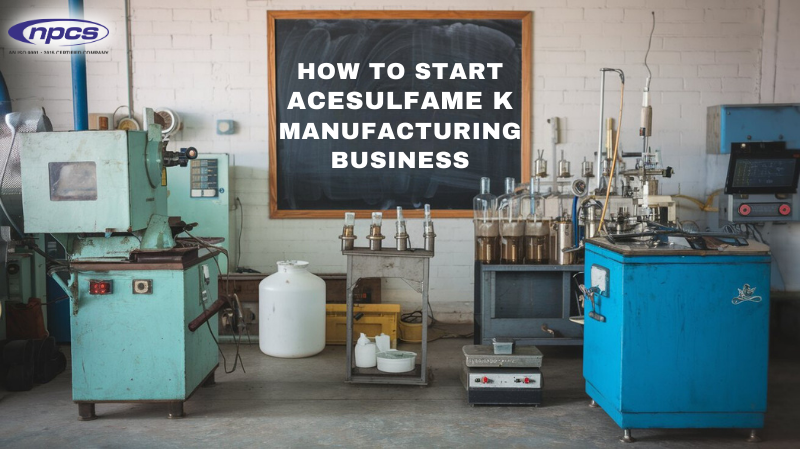Acesulfame K is a non-caloric artificial sweetener which finds application in many industries, food and beverages being the most popular. Its zero calorie content and a sweetness level much higher than sugar. It makes it a worthy substitute for ordinary sugar, more so in low calorie and sugar free range of products. However, with more and more people becoming health conscious and looking for foods containing less or no sugar. Starting an Acesulfame K production business seems to be a very beneficial endeavor. Taking this book you will learn everything that includes the basics of the product and assess the market opportunities . As well as the technology and methods necessary for its production and paths of achieving success.
What is Acesulfame K?
Acesulfame K, sometimes also expressed as Acesulfame potassium and Ace K is a non-caloric sweetener. Which is 200 times greater than the sweet of table sugar. It is stable when heat is applied and has a very long shelf life making it appropriate for the desired application. For many food and non food products. Acesulfame K is also found in many other instances where sweetening agents such as aspartame or sucralose. They are used to enhance the flavors of diet beverages, bakery items, and even emulsified products.
Why Start an Acesulfame K Manufacturing Business?
Despite the challenges it presents, Acesulfame K manufacturing business has got many benefits. It makes it an appealing business for entrepreneurs:
- Health-Conscious Consumer Demand: With a growing global focus on reducing sugar consumption. Especially because of the rising cases and awareness of diabetes and obesity. There is a growing market for artificial sweeteners such as Acesulfame K in food and beverage products.
- Expanding Applications: Acesulfame K has many uses in different sectors, for example food and beverage, pharmaceuticals and cosmetics, which makes it a multipurpose product.
- Sustainable Growth: It is expected that the market for artificial sweeteners will continue to develop at a steady rate. Because of increasing concern for health and the tendency towards the use of sugar free or low calorie foods and beverages.
- Global Prospects: Acesulfame K has potential outside domestic markets; there is a huge opportunity for trade and growth in business on a Global scale.
Benefits of Starting an Acesulfame K Business
- Increasing Reach: Asia Pacific Sweeteners Market has been rising at a fast rate with the health-conscious population encouraging the use of sugar-free sweeteners such as acesulfame K.
- Industry Versatility: Acesulfame K finds its applications in several industries, including but not limited to food and beverage, pharmaceutical, cosmetics and personal care manufacture.
- Flexibility: The process of production can be customized for both productive and scalable processes, which gives you the option to begin with few units and improve units as per the need.
- Overseas Markets: Acesulfame K is popular in all parts of the globe. Therefore, there are prospects for international commerce. The business has high potential for entrepreneurs who are ready to go beyond the domestic market.
Top Applications of Acesulfame K
Acesulfame K finds applications in:
- Food and Beverages: This sweetener is advised in zero-calorie drinks, dairy products, confectionery products, and bakery products.
- Pharmaceuticals: This is a useful compound when developing liquid syrups and tablets.
- Cosmetics: Acesulfame K sweetener is used in the making of products such as toothpaste and mouthwash which have a sweet taste and remain stable.
Production Methods
The synthesis of Acesulfame K is carried out through a chemical procedure called oxidation of derivatives of acetoacetic acid and potassium salts. The tower is a textured view of the process of fabrication:
- Raw Material Procurement: Mostly, the chemicals used in making Acesulfame K are acetoacetic acid derivatives and potassium hydroxide, which are the primary raw materials needed.
- Chemical Synthesis: Acesulfame K is obtained through the oxidation of some derivatives of acetoacetic acids. Under basic conditions of a solution containing potassium hydroxide. The reaction proceeds in several stages that have to be controlled in order to obtain the product of given quality.
- Crystallization and Purification: After synthesis j the Acesulfame K is crystallized and purified so that it is fit for food grade purpose.
- Drying and Packaging: The end product will be dried and the finished goods stored in containers which are safe for food products before they are transported to food, drinks and pharmaceutical companies.
- Safety and Quality Control: One of the main aims is to uphold the international food safety and quality standards during the manufacturing process of Acesulfame K in order to maintain its purity and safety.
Essential Machinery for Acesulfame K Manufacturing
Setting up an Acesulfame K manufacturing plant requires specific equipment to ensure efficient and safe production. Key machinery includes:
- Reactors: This equipment is utilized during the chemical synthesis breed which is responsible for the oxidation reactions.
- Crystallizers: Apparatus that allows building clean Acesulfame K right after the synthesis process is completed.
- Filtration Systems: Equipment used for extracting the finished product and for eliminating the leftover components.
- Drying Units: Equipment used to make sure that Acesulfame K is free of moisture content before it’s packed.
- Packaging Machines: for use in automated packing in food-grade Cans.
Starting Your Acesulfame K Manufacturing Business
Here are the steps to get your business started:
- Conduct Market Research: Assess if there is any need for Acesulfame K in the respective food manufacturers, pharmaceutical, and beverage markets you are targeting.
- Develop a Business Plan: Write a detailed document that encompasses production targets, marketing methods, financial plan as well as operational outlines.
- Regulatory Compliance: First and foremost, appropriate licenses and permits must be obtained while ensuring the manufacturing process. It is a compliant with food safety standards set by the FDA and other similar authorities available in the region.
- Set Up a Manufacturing Plant: A production house comprising necessary machinery should be erected with a functional exhaust mechanism and safety features in place.
- Sourcing of Raw Materials: Develop a reliable network of partners and sign long-term agreements for the supply of materials such as acetoacetic acid derivatives and potassium hydroxide.
- Implementation of Quality Control: Carry out stringent quality control practices at every stage of production. In order to achieve the desired quality of the products manufactured.
- Marketing and Sales Strategy: Create a marketing plan addressing possible customers, such as food and drink manufacturers, pharmaceutical companies, and retailers. Emphasize the advantages of your improved Acesulfame K in marketing efforts.
- Research and Development: The production enhancement and new products applications are achieved by r&d. Thus, it is essential to adopt the trends within the industry and develop production capabilities.
Conclusion
Establishing an Acesulfame K producing enterprise is highly appealing especially now when sweeteners devoid of calories are gaining popularity. If one manages to implement the appropriate planning, infrastructure, and marketing approach. He/she will be able to take advantage of this growing demand. What’s more, these measures coupled with compliance to the set regulations, and an emphasis on creativity. It will make it possible for one to forecast the future of the business within the food additives sector.






